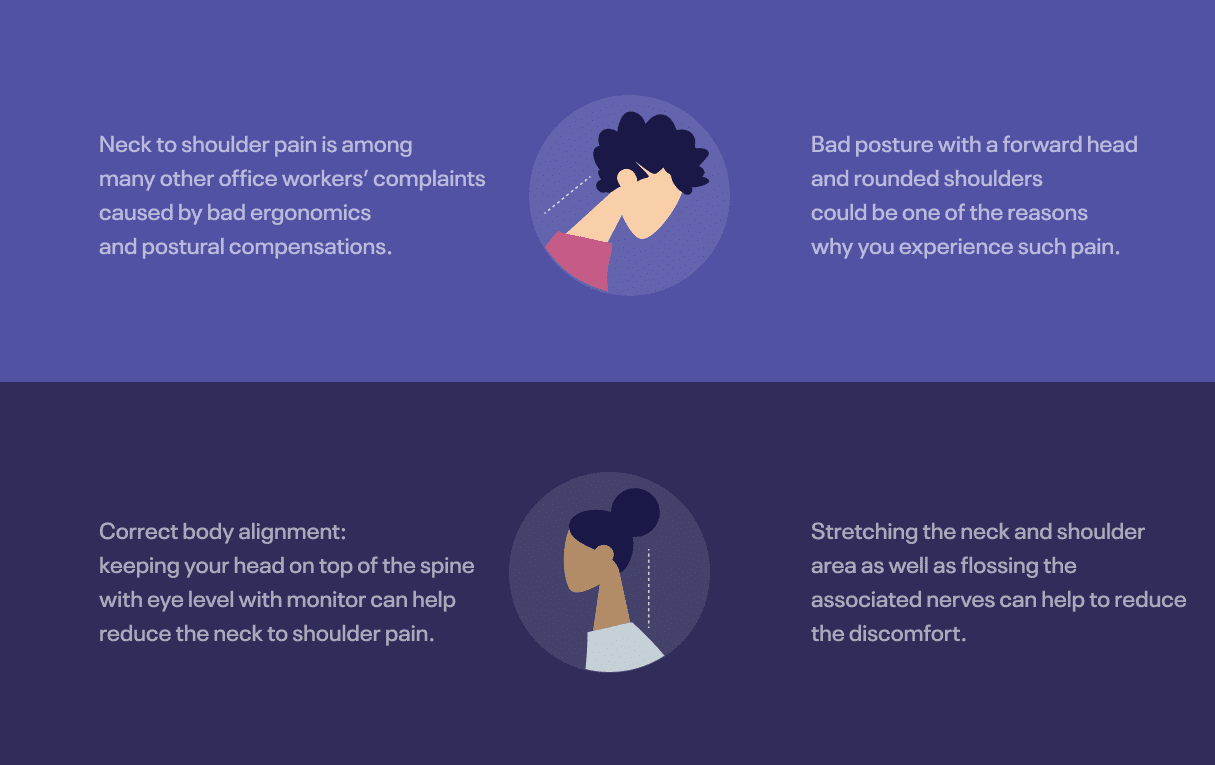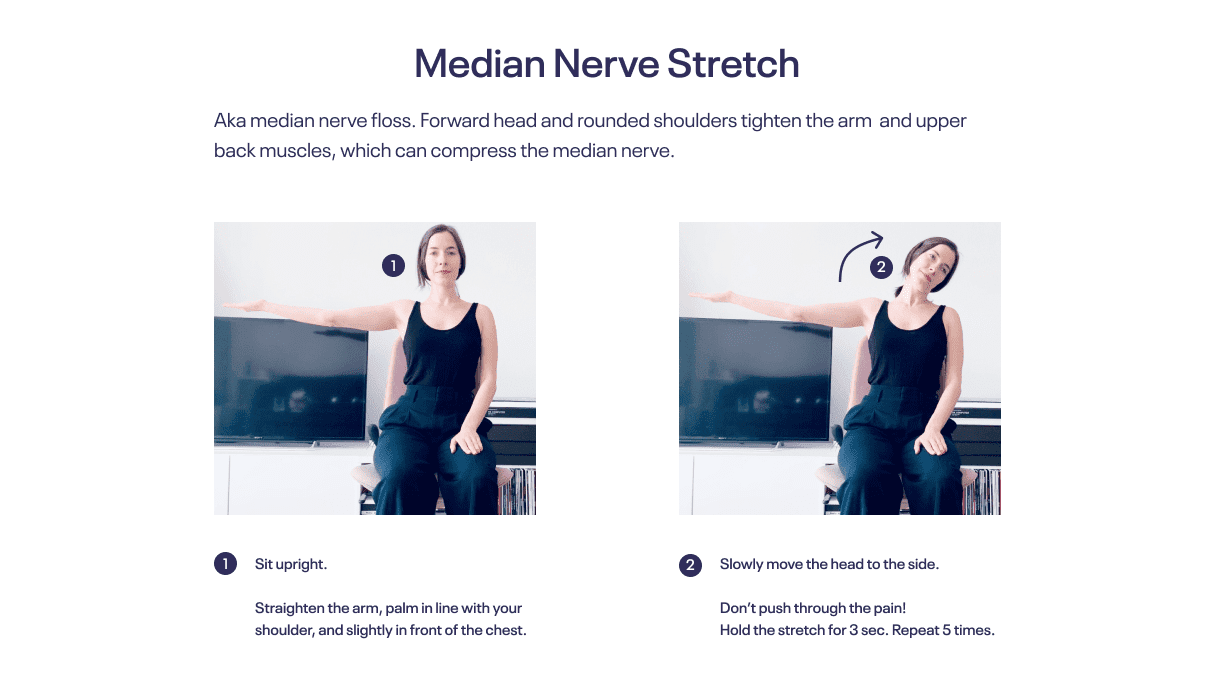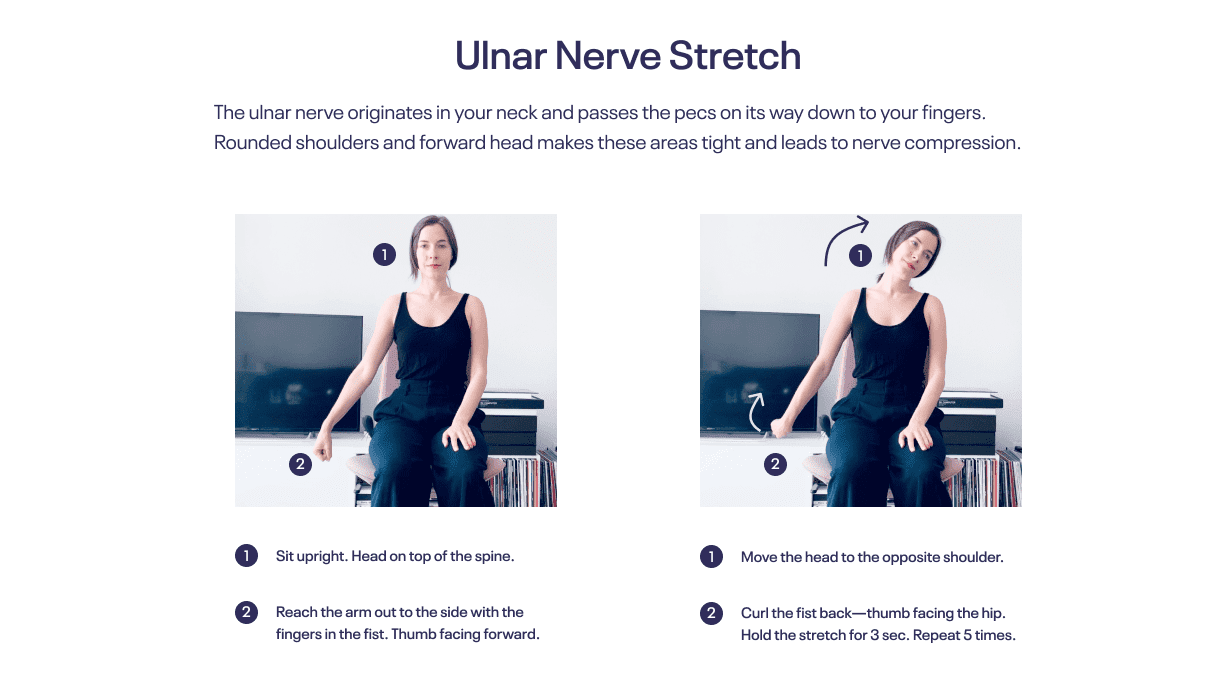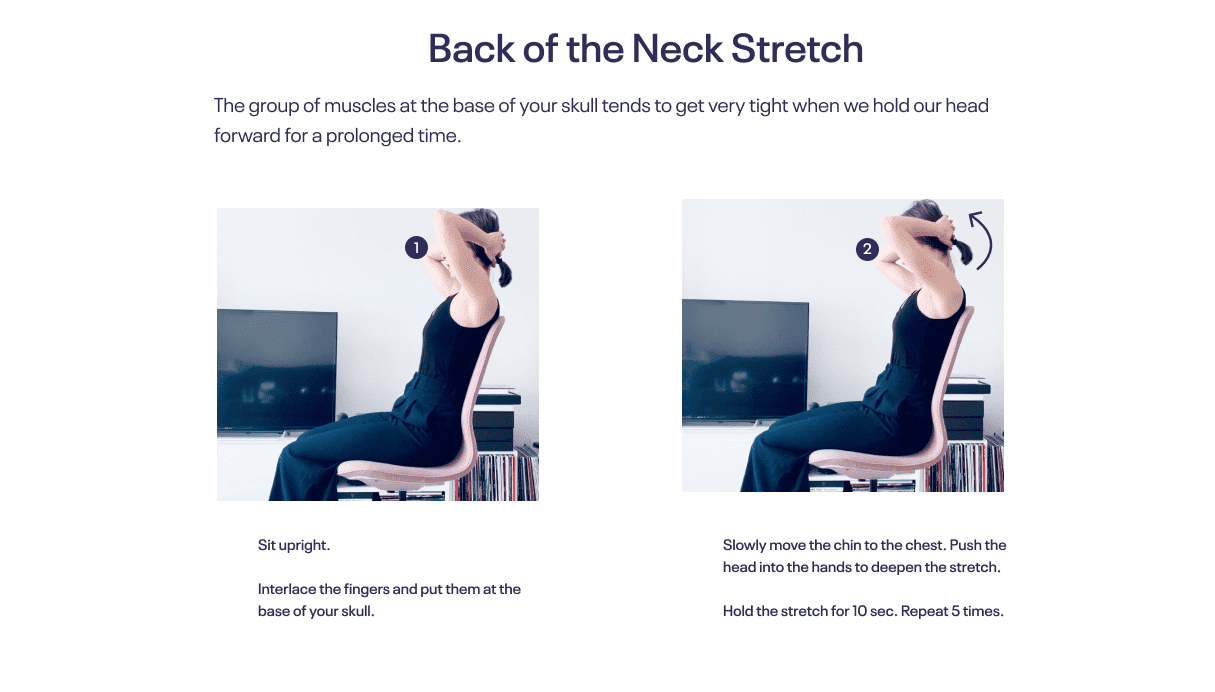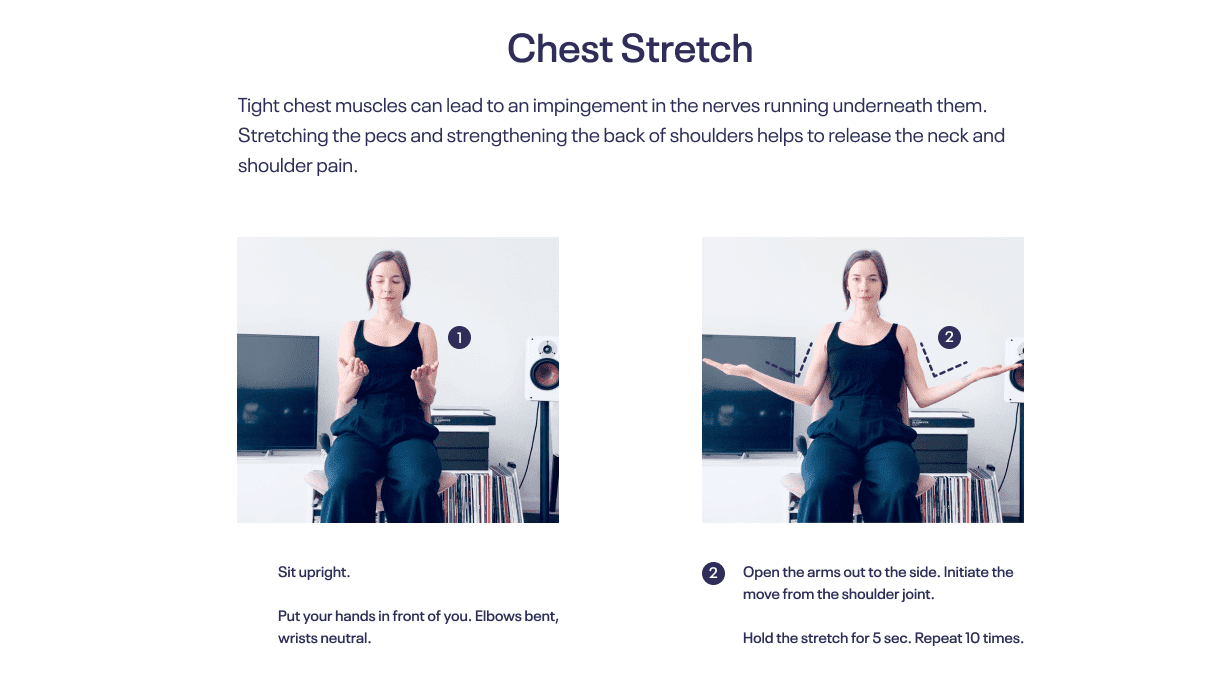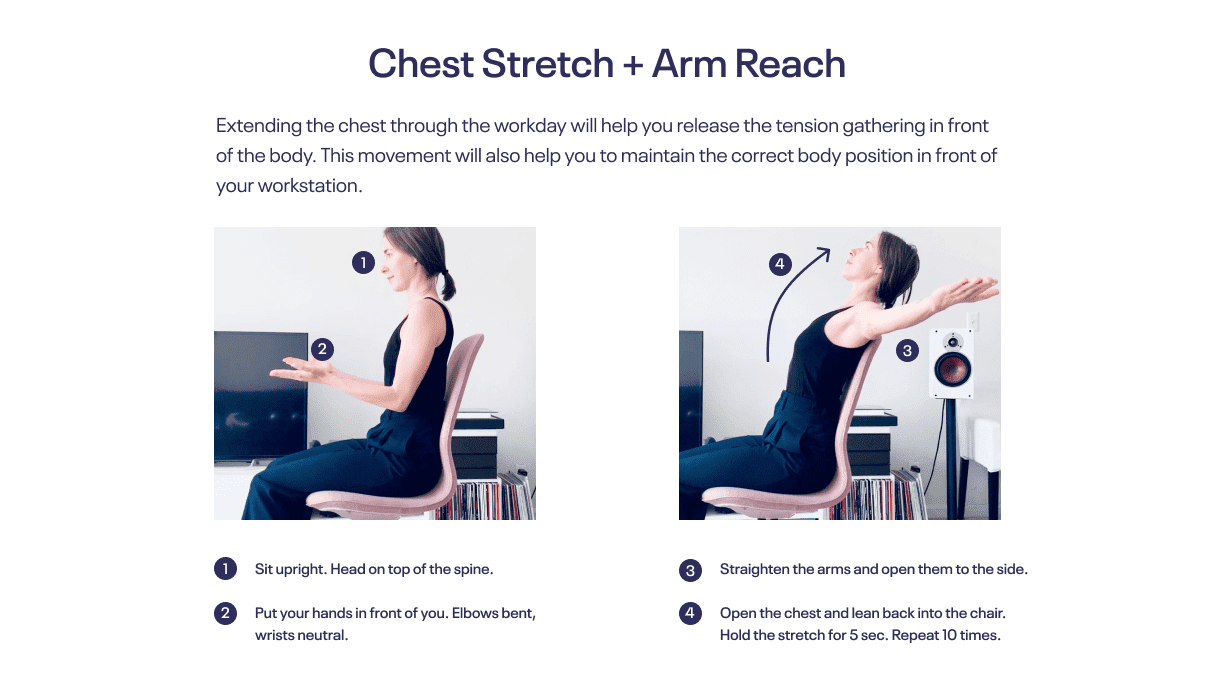Pain from the Neck to Shoulder. Causes and 5 Helpful Stretches.
If you experience a pain that goes from your neck down to the shoulder, know that this is a relatively common discomfort that many people struggle with. Some of these people spend many hours in front of a computer, where their postures, without them knowing, gradually changes, causing numerous aches. Neck to shoulder pain is among many other office worker complaints caused by bad ergonomics and postural compensations.
Look at the way you sit in front of your computer. This might be one of the places where you commit a lot of postural crimes.
There are, of course, other reasons, unrelated to what you do in front of your desk, that can cause this particular pain. In this article, I’ll list the most common causes of neck to shoulder pain and show you five easy stretches to ease the discomfort.
Most Common Causes of Neck to Shoulder Pain
Before we go to the helpful stretches, it is important to distinguish different types of neck to shoulder pain. Bad posture with a forward head and rounded shoulders could be one of the reasons why you experience such pain, but it isn’t always the case.
Here are the four most common conditions associated with neck to shoulder pain:
Rotator Cuff Tear
Your rotator cuff is built from four deep muscles:
- subscapularis
- teres minor
- supraspinatus
- infraspinatus.
These muscles keep the arm bone in its socket, stabilizing it when it moves in space. The weakness of this muscle group can often lead to a tear, especially during sports that demand a lot of motion in the arms. Think swimming, or ball sports (from the big ball- basketball to the small ball- golf).
Rotator cuffs are prone to get hurt as we go through repetitive motions without sufficient prior strengthening. Your rounded shoulder posture, slowly developed in front of various screens, also contributes to that problem. Especially if you start your fun workouts without an appropriate warm-up for the shoulder joint.
Check out these easy exercises to add to your routine for rotator cuff strengthening:
(Shoulder Pain Exercises. The Magic of the Rotator Cuff.)
Nerve Impingement
Your cervical spine (neck) is surrounded by nerves that branch off the spinal cord and innervate the neck, shoulder, and arm down to fingers.
A pinched nerve in the neck can cause the pain, tingling, or numbness to travel down to the shoulder or your arm. This particular type of impingement is called cervical radiculopathy. It can be caused by injury (e.g., whiplash) related to neck or again develops as a result of bad posture. The nerve root becomes inflamed and, in effect, damaged. Other body conditions, such as bulging cervical vertebrae, can often cause impingement.
Check how you can floss your nerves to keep them healthy:
(10-minute nerve flossing routine to ease your carpal tunnel discomfort)
Cervical Disc Herniation
The primary function of your seven cervical vertebrae is to support the weight of the head (10 pounds!).
Between each of your vertebrae sits a soft intervertebral disc. It feeds the vertebrae and gives it cushioning that prevents the bones from rubbing into each other. When the fluid that sits inside the disc (nucleus) is pushed out due to strain or injury, it presses against the nerve roots resulting in pain. Bulged discs can lead to an unpleasant pain in your neck and shoulders or even weakness in arms.
Check out the safe exercise to ease the discomfort for bulging discs:
(Herniated disc in the neck. 10-minute exercise and stretch routine for immediate relief.)
Mouse Shoulder
"Mouse shoulder" or "trackpad shoulder" is a condition that develops when you adapt a slouched seated posture while holding your arm outstretched, gripping a mouse or trackpad for many hours a day.
This condition usually affects the dominant side of the neck, shoulder, and arm. Muscles and tendons from the neck down to your wrist are contracted continuously to support this outstretched position. The shortened muscles start to pull on your shoulder and neck. Moreover, holding your arm in this static position can lead to an impingement in various nerves in your arms.
Doctor Warning:
These conditions described above can feel similar, so in case you are not sure what is exactly troubling you, seek medical help. Your doctor will refer you to the appropriate specialist that can determine what is the issue and prescribe needed treatment.
Note that in some cases, this pain could be indicating more severe problems in your body, such as heart attack, stroke, or cancer.
I don't want to cause a panic. Observe your body, and if you suspect that your pain might be coming from something less innocent that postural reasons always contact your physician.
5 Stretches for Neck to Shoulder Pain to Do at Your Desk
For a quick fix for those tight shoulders and neck, try stretching the appropriate body parts. These five stretches listed below will not only lengthen the muscles but also floss the nerves that run from your neck down your arm.
-
Median Nerve and Neck Stretch
Your median nerve delivers sensations to your thumb, first two fingers, and part of your third finger. When the nerve gets compressed somewhere on its pathway, it can lead to carpal tunnel syndrome. The carpal tunnel syndrome doesn’t always start in your wrist. Forward head and rounded shoulders tighten the arm and upper back muscles with can compress the median nerve.
Movement:
Hold your left arm outstretched and bend your head to the right. Hold for 3 seconds. Repeat five times and switch the arm.
-
Ulnar Nerve and Neck Stretch
The ulnar nerve delivers sensations to part of your 3rd finger (ring finger) and your 4th finger (pinkie). The ulnar nerve originates in your neck and passes the pecs (chest muscles) on its way down to your fingers. Bad posture with rounded shoulders and forward head makes these areas tight and leads to nerve compression.
Movement:
Hold your left arm down with the wrists flexed, fingers curled. Bend your head to the right and turn your wrist back. Hold for 3 seconds. Repeat five times and switch the arm.
-
Back of the Neck Stretch
The group of muscles at the base of your skull tends to get very tight when we hold our head forward for a prolonged time. It is essential to stretch them through the day to release the tension as well as remind ourselves about the correct position of your head on top of the spine.
Movement:
Interlace your fingers behind your head. Push your head back into your palms, and nod your chin to the chest. Hold for 10 seconds. Repeat five times.
-
Chest Stretch
Tight chest muscles can lead to an impingement in the nerves that run underneath them. With our ever-present rounded shoulders and forward head, we create tension in the upper chest area. Stretching the pecs and connecting to the back of shoulders will help you to release the neck and shoulder pain.
Movement:
Bend your elbows by your side. Start externally rotating from the top of your arm bone. Keep your collarbones and shoulder blades broad. Hold for 5 seconds. Return to starting position. Repeat ten times.
-
Chest Stretch + Arm Reach
Extending the chest through the workday will help you release the tension gathering in front of the body. This movement will also help you to maintain the correct body position in front of your workstation.
Movement:
From the previous stretch position, start reaching your breast bone up. Lean against the back support of your chair and reach your arms out to the side, thumbs facing back. Hold for 3 seconds. Return to starting position. Repeat five times.
Strengthen Your Upper Back
Stretching is very helpful in releasing the neck and shoulder pain. However, it is essential to combine it with the appropriate strength training. Your upper back muscles need to get stronger to support the correct alignment of your body. The stronger upper back will improve your quality of life in front of your desk as well as outside your workstation.
Constantly stretching what's tight won't change your life significantly. Stretching works best when combined with strength.
To bring it up to the next level, try this shoulder and upper back strength and release routine:
(Shoulder pain– 10 minute routine for office workers and weekend warriors to alleviate the discomfort)
The daily dose of exercises is essential to stay healthy, mobile, strong, and pain-free. Subscribe to Relevel App today to improve your quality of life behind the desk and beyond.
